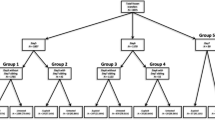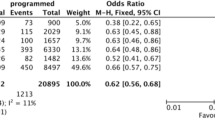Abstract
Purpose
Frozen embryo transfer has been established as an indispensable ART procedure for both the effective use of surplus embryos and the prevention of ovarian hyperstimulation syndrome. The frequency of frozen embryo transfer is increasing in our clinic, and we report that frozen embryo transfer is effective for patients with repeat failures. We present our clinical outcome of frozen blastocyst transfer (FBT).
Methods
In 2006, 470 patients received FBT (562 cycles (IVF: 354 cycles; ICSI: 208 cycles)). One frozen blastocyst was transferred in 412 cycles (335 patients) and two blastocysts were transferred in 150 cycles (135 patients). Assisted hatching was performed in all cases.
Results
In 412 cycles (average age: 34.6 years) who received a single FBT, the rate of clinical pregnancy per cycle was 40.7%, the live birth rate was 29.1%, the abortion rate was 21.6%, the ectopic pregnancy rate was 1.2%, the frequency of monochorionic twins was 2.3%, and the cesarean section rate was 38.3%. In 150 cycles (average patient age 34.8 years) who received two FBTs, the clinical pregnancy rate was 46%, the live birth rate was 35.3%, the abortion rate was 16.3%, the ectopic pregnancy rate was 4.4%, the frequency of twins was 15.9% and the cesarean section rate was 39.6%. A significant difference in the ectopic pregnancy rate and the twinning rate was found between single transfers and double transfers (P < 0.05). When IVF and ICSI were compared, there was no statistically significant difference in the abortion rate, the ectopic pregnancy rate, and the cesarean section rate.
Conclusions
The clinical pregnancy rate was similar for the transfer of one and two blastocysts. Single FBT decreases obstetrical risk without reducing the pregnancy rate.
Similar content being viewed by others
References
Kinget K, Nijs M, Cox AM, Janssen M, Jacobs P, Bosmans E, et al. A novel approach for patients at risk for ovarian hyperstimulation syndrome: elective transfer of a single zona-free blastocyst on day 5. Reprod Biomed Online. 2002;4(1):51–0.
Khalaf Y, El-Toukhy T, Coomarasamy A, Kamal A, Bolton V, Braude P. Selective single blastocyst transfer reduces the multiple pregnancy rate and increases pregnancy rates: a pre- and postintervention study. BJOG. 2008;115(3):385–90. doi:10.1111/j.1471-0528.2007.01584.x.
Mukaida T, Nakamura S, Tomiyama T, Wada S, Kasai M, Takahashi K. Successful birth after transfer of vitrified human blastocysts with use of a cryoloop containerless technique. Fertil Steril. 2001;76(3):618–20. doi:10.1016/S0015-0282(01)01968-9.
Schwärzler P, Zech H, Auer M, Pfau K, Göbel G, Vanderzwalmen P, et al. Pregnancy outcome after blastocyst transfer as compared to early cleavage stage embryo transfer. Hum Reprod. 2004;19(9):2097–102. doi:10.1093/humrep/deh398.
Barrenetxea G, López de Larruzea A, Ganzabal T, Jiménez R, Carbonero K, Mandiola M. Blastocyst culture after repeated failure of cleavage-stage embryo transfers: a comparison of day 5 and day 6 transfers. Fertil Steril. 2005;83(1):49–53. doi:10.1016/j.fertnstert.2004.06.049.
Levitas E, Lunenfeld E, Har-Vardi I, Albotiano S, Sonin Y, Hackmon-Ram R, et al. Blastocyst-stage embryo transfer in patients who failed to conceive in three or more day 2-3 embryo transfer cycles: a prospective, randomized study. Fertil Steril. 2004;81(3):567–71. doi:10.1016/j.fertnstert.2003.08.031.
Davis LB, Lathi RB, Westphal LM, Milki AA. Elective single blastocyst transfer in women older than 35. Fertil Steril. 2008;89(1):230–1. doi:10.1016/j.fertnstert.2007.02.047.
Lyu QF, Wu LQ, Li YP, Pan Q, Liu DE, Xia K, et al. An improved mechanical technique for assisted hatching. Hum Reprod. 2005;20(6):1619–23. doi:10.1093/humrep/deh809.
Gardner DK, Lane M. Embryo culture system. In: Trouson AQ, Gardner DK, editors. Handbook of in vitro fertilization. 2nd ed. Boca Raton (FL): CRC; 2000. p. 205–64.
Gelbaya TA, Nardo LG, Hunter HR, Fitzgerald CT, Horne G, Pease EE, et al. Cryopreserved-thawed embryo transfer in natural or down-regulated hormonally controlled cycles: a retrospective study. Fertil Steril. 2006;85(3):603–9. doi:10.1016/j.fertnstert.2005.09.015.
Kawamura T, Motoyama H, Yanaihara A, Yorimitsu T, Arichi A, Karasawa Y, et al. Clinical outcome of two different endometrial preparation methods for cryopreserved-thawed embryo transfer in patients with a normal menstrual cycle. Reprod Med Biol. 2007;6:53–7. doi:10.1111/j.1447-0578.2007.00165.x.
Gabrielsen A, Agerholm I, Toft B, Hald F, Petersen K, Aagaard J, et al. Assisted hatching improves implantation rates on cryopreserved-thawed embryos. A randomized prospective study. Hum Reprod. 2004;19(10):2258–62. Epub 2004 Aug 19.
Leniaud L, Poncelet C, Porcher R, Martin-Pont B, Cédrin-Durnerin I, Hugues JN, et al. [Elective single-embryo transfer versus double-embryo transfer following in vitro fertilization: a two-year French hospital experience]. Gynecol Obstet Fertil. 2008;36(2):159–65. Epub 2008 Feb 5, 2008.
Peramo B, Ricciarelli E, Cuadros-Fernández JM, Huguet E, Hernández ER. Blastocyst transfer and monozygotic twinning. Fertil Steril. 1999;72(6):1116–7. doi:10.1016/S0015-0282(99)00412-4.
Derom C, Vlietinck R, Derom R, Van den Berghe H, Thiery M. Increased monozygotic twinning rate after ovulation induction. Lancet. 1987;30:1236–8. doi:10.1016/S0140-6736(87)92688-2.
Yanaihara A, Yorimitsu T, Motoyama H, Watanabe H, Kawamura T. Monozygotic multiple gestation following in vitro fertilization: analysis of seven cases from Japan. J Exp Clin Assist Reprod. 2007;4:4. doi:10.1186/1743-1050-4-4.
Schieve LA, Peterson HB, Meikle SF, Jeng G, Danel I, Burnett NM, Wilcox LS. Live-birth rates and multiple-birth risk using in vitro fertilization. JAMA. 1999;282(19):1832–8. doi:10.1001/jama.282.19.1832.
Author information
Authors and Affiliations
Corresponding author
Rights and permissions
About this article
Cite this article
Yanaihara, A., Yorimitsu, T., Motoyama, H. et al. Clinical outcome of frozen blastocyst transfer; single vs. double transfer. J Assist Reprod Genet 25, 531–534 (2008). https://doi.org/10.1007/s10815-008-9275-5
Received:
Accepted:
Published:
Issue Date:
DOI: https://doi.org/10.1007/s10815-008-9275-5




